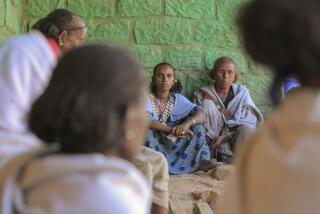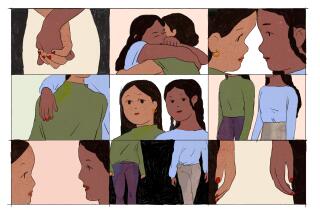Making Local Fictions International ‘Facts’
- Share via
As an anthropologist studying Eritrea and Ethiopia, I am dismayed at the way the international media have approached and reported on the current escalating border conflict between the two nations.
I was evacuated from Asmara, the capital of Eritrea, on the evening of June 5, several hours after the initial bombings of the airport by Ethiopian warplanes. It is clear to me now, as it was then, that although Eritreans do not want to return to war, they are willing and able to defend the nation they sacrificed three decades and countless lives to create.
More generally, it is also clear that both Eritrea and Ethiopia cannot sustain more losses to their economies, infrastructures or, most important, their people. Yet the inability of most media sources to adequately assess and comment on the highly contested and contradictory nature of the events in these two countries remains equally disheartening.
Emerging from the abundance of news reports has not been a clearer picture of the “truth,” if such a thing exists, but rather a plain example of how the media are instrumental in transforming local fictions into international facts. Moreover, the lack of historical and cultural knowledge on the part of reporters as well as naivete about Eritrean and Ethiopian political climates have only obfuscated a more thorough understanding of the recent war. This is a great disservice to the people of Eritrea and Ethiopia as well as to the international community.
Most people familiar with Eritrea and Ethiopia are aware that Ethiopia has always possessed a more vigorous press and a more vocal government. Eritrea has but one state-administered newspaper as well as a government that measures its words carefully, preferring to say less than more. To the foreigner, Eritrean society seems at once welcoming, friendly and hospitable while at the same time reserved in what it tells about itself, disinterested in the opinions of outsiders and fiercely loyal to its government and the recent revolution.
As a result of these factors, the media have undoubtedly been given far more access to Ethiopian accounts of the conflict. Even the language contained in so many articles and reports betrays this reality. Referring to Eritrean independence as either “secession” or as a “reward” from Ethiopia after the exile of Col. Mengistu Haile Mariam in 1991 attests to a viewpoint obtained on only one side of the border (wherever it might be).
Similarly, characterizations of Eritrean “aggressiveness” in other disputes, such as the one with Yemen over the Hanish islands, reveal an ignorance of conditions specific to that situation. Additionally, common sense would seem to dictate that any account given by either government, whether it be an accusation of first blood or casualty figures, has undoubtedly been shaped by disruptive political elements brewing between and within the two nations, of which the current conflict is but an expression.
Among anthropologists, it is an adage that cultures and societies actively construct their own realities, histories and narratives. Eritrea and Ethiopia are fascinating and rich examples of this. They also point out that such constructions of reality can be dangerous and bewildering on both regional and international levels. Yet the mainstream media rarely seem to take this into consideration when generating “factual” accounts for public consumption.
Media reports can be just as constructed and fictional as the “stories” they capture. In the context of what the media have dubbed a new “African Renaissance,” which Eritrea and Ethiopia were said to represent, publications with claims to international coverage have a serious responsibility to enter into a new era of reporting on Africa, one which takes into account the often complex and contradictory political, cultural and social milieu in which current events take place.
More to Read
Sign up for Essential California
The most important California stories and recommendations in your inbox every morning.
You may occasionally receive promotional content from the Los Angeles Times.













